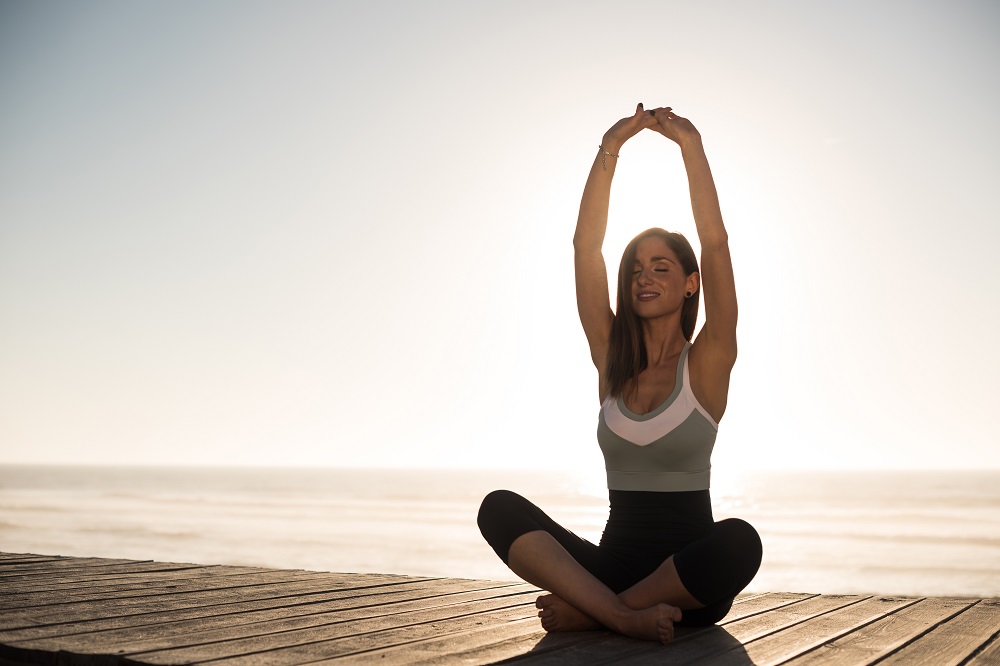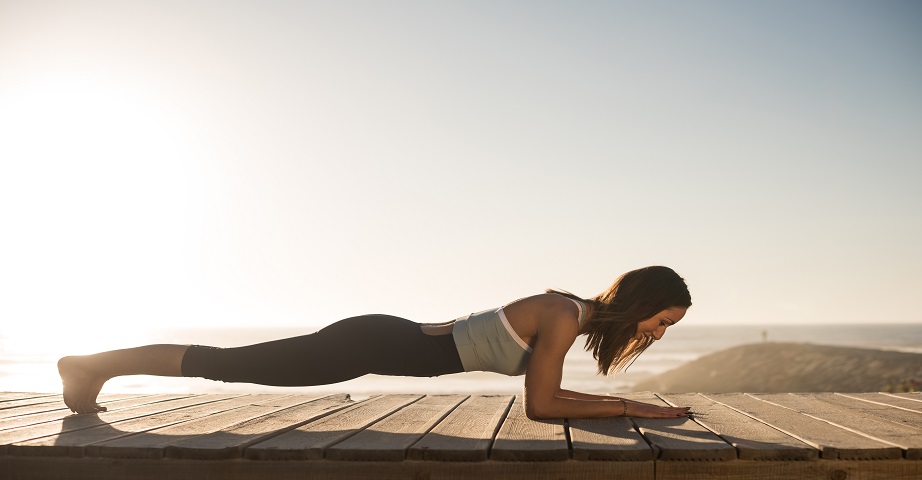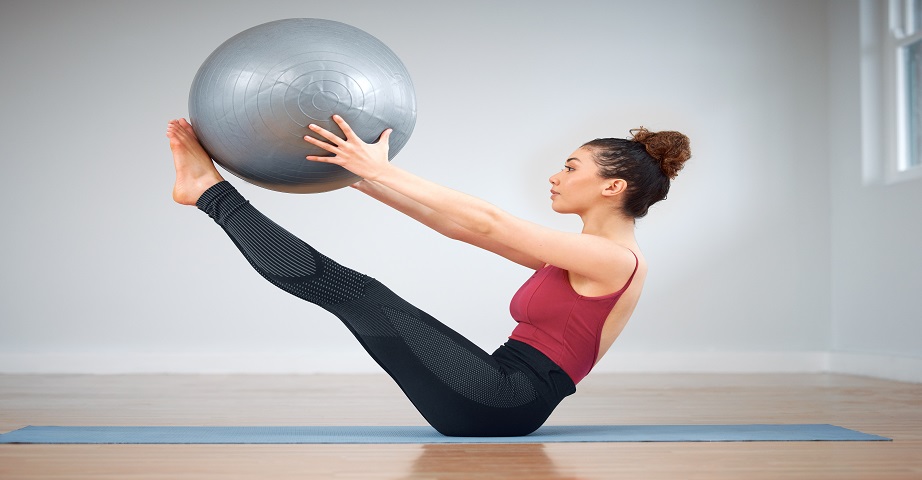Pilates - holistic training, or exercises for the body, mind and breath

Pilates is a method of exercises with low dynamics and extraordinary precision, which strengthens all muscle parts, focusing primarily on stretching the body. This is a type of activity that can not only improve well-being, but also reduce back pain and have a positive effect on ailments associated with the musculoskeletal system. In addition, the Pilates can increase range of motion and improve body posture. It is a discipline suitable for almost everyone, which can be adapted to the individual needs of the practitioner.
Is it worth practising the Pilates? What are its rules and what exercises should be done during the Pilates training?
Pilates - what is it?
Pilates is a universal training that strengthens all muscle parts. It is a system of exercises combining elements of yoga, tai-chi and ballet and gymnastics. It was developed in the 20s. XX century by the German athlete Joseph Pilates for his own use - Pilates struggled with rickets and other back pain. According to the assumptions of the athlete, the Pilates is a method of activity that contribute to strengthening the muscles without their excessive development, and is also relieving the spine. In addition, Joseph Pilates wanted that the exercise system, which he developed, make the body more flexible, lower stress levels and improve overall health.
Initially, the exercise method was mainly used during the rehabilitation of ballet dancers to restore them to full condition after all kinds of injuries. The wide world of fitness became interested in the discipline only in the 90s. XX century. Since then, the Pilates activities are becoming more and more popular and are offered by almost every sport club, and there is no shortage of people willing to practice this technique of exercise.
The Pilates is a set of exercises that is based largely on isometric exercises, that is, during which muscle tension occurs while maintaining a constant length of muscle fibers. It is a method that is distinguished by low dynamics, but extraordinary precision. The Pilates focuses on the activation of core muscles, stabilizing the spine and pelvis. In addition, breathing is also an important aspect of this type of training.
8 rules of Pilates
When using the Pilates method of exercise, it is worth following eight key rules that facilitate the work of the body and understanding, which is why this form of activity is so unique.
- Concentration - the body and mind during exercise should be fully synchronized. Without concentration during physical activity, you can forget what its purpose is. During the Pilates, movements should be combined with a thought process. It is a physical effort that requires 100% concentration on a given activity and exercise.
- Breath - the right breath gives the exercises the right rhythm. It also allows you to focus on the activities performed, improves oxygen exchange in cells and increases lung capacity. Proper breathing is essential for proper exercise. During the Pilates, a slight tension of the transverse abdominal muscle should be maintained, therefore the recommended breathing method is lateral-rib breathing, which can facilitate the maintenance of a stable body.
- Centering - in the Pilates, every movement begins with the tension of the deep muscles, and then the muscles that initiate the activity are turned on.
- Control - allows you to coordinate the work of the body with the mind. Exercises should be performed without haste, while maintaining full control. The slow pace of activity allows you to keep the body in the right position and activate slow-twitch muscles.
- Precision - in the Pilates, the accuracy of the exercises is more important than their quantity. Therefore, during activity, you should focus on maintaining the natural curvatures of the spine and positioning the pelvis in a neutral setting. This makes it possible to develop correct movement patterns.
- Continuity of movement - the Pilates is a training performed in motion, but the way it is performed is also extremely important - it should be continuous and smooth. One position should move into another without sudden changes.
- Balanced muscle development - the goal of the Pilates is sustainable muscle development. Exercise helps strengthen weakened muscles and relax those overly tense. The Pilates instructs how to use muscles to make their work uniform and balanced.
- Routine - repetition of exercises leads to better control of movement, and systematic training allows you to consolidate changes in the body, among others, improving posture and increasing muscle flexibility.
According to the statement of J. Pilates - after ten sessions you will feel the difference, after twenty workouts you will see it, and after thirty you will have a completely new body.
Recommended products
Pilates - for who?
The Pilates is a system of exercises suitable for almost everyone. Training can be performed not only by healthy and fit adults, but also by seniors or people struggling with various types of pain, resulting, among others, from a sedentary lifestyle.
The benefits of practising the Pilates can be felt by people who suffer from reduced well-being, as well as those who lack motivation to action. The training method can also be a good solution among stressed people whose body is tense, as well as among people who want to look good.
The Pilates is also a good solution for physically active people - exercises can increase mobility of movements and reduce the risk of injury, and thus can have a positive effect on training efficiency associated with other sports.
Pilates - exercise effects, advantages and benefits. How does Pilates affect the body?
The Pilates exercises can primarily improve your well-being and provide you with more energy to live. In the longer term, the effort may also contribute to:
- slender figure,
- muscle strengthening,
- increase the flexibility of the body,
- improving balance,
- tone the spine,
- improving condition,
- sculpting muscles without their excessive expansion.
The Pilates can also delay joint aging, strengthen the chest and deep muscles, as well as help maintain normal body posture and support motor coordination. Training developed by a German athlete is also an excellent way to learn how to breathe properly, which can, among other, have a calming effect and contribute to reducing stress levels.

Pilates for beginners - how to start?
The Pilates is a pleasant, non-burdening training, which is, however, very demanding. In order to observe the desired effects of the Pilates, exercises should be performed regularly and accurately, with the right precision. How to prepare for the Pilates? What outfit is suitable for this type of activity?
The Pilates outfit should be comfortable and well-fitting, so that it does not interfere with making individual movements and moving from the starting position to the next figure. The best option is to do activities barefoot or in socks. The Pilates does not require special preparation. This is a safe and pleasant form of effort, which should start with the right warm-up.
The Pilates exercises originally consisted of doing activities without the use of additional equipment. From this form of training, it is worth starting the adventure with the Pilates - using only a gym mat.
In order to do the exercises well, you should focus first on proper breathing and maintaining the right posture. The Pilates training can be started at home, using instructional videos available on the Internet, however, a safer and more recommended option is to use Pilates lessons at a nearby gym or sports club or individual cooperation with a qualified trainer in this area. The instructor will pay attention to the correctness of the positions performed, and additionally motivate you to continue.
When starting to do the Pilates exercises for beginners, you need to know the starting positions, called neutral ones. The neutral lying position consists of lying flat on your back with your arms placed along the body and your heels slightly pressed into the floor, while maintaining a neutral spine. In turn, the sitting starting position is a seat with straight back and legs bent at the knees, with simultaneous flat placement of feet on the ground. The hands should then be lowered along the torso, while the neck extended upwards. When doing the Pilates, remember to tense the abdominal, back and pelvic muscles at the same time during exercise.
When doing exercises on the mat will become trivial for you, and the basic Pilates techniques will be mastered, it is worth adding additional equipment to the activities performed, which can not only diversify your workouts, but also to ensure you development and progress.
Pilates - what exercises?
The Pilates consist in making slow and smooth movements. These are many exercises that focus on stretching, increasing flexibility and muscle strength. They can have different degrees of difficulty and be performed with or without additional equipment. Examples of exercises practiced in the Pilates training include.:
- Stretching legs - when lying on your back, pull your knees to your chest and hold them with your hands below the knee line. Tighten the abdominal muscles, raise the head and shoulders. Exhale slowly, relax your muscles, raise your arms and straighten them over your head, and stretch your legs forward. Breathe in and pull your knees back to your chest. Return to the starting position.
- Straightening the legs - in the supine position, raise the legs vertically up so that a right angle is formed in the hips. Wrap your hands in the back of your head and tighten your abdominal muscles. Stay in this position for a few seconds and relax your muscles. Return to the starting position.
- Strengthening the Kegel muscles - take a position in the four-point kneeling. Take a deep breath, and during the exhalation tighten the abdominal muscles. Relax your muscles by inhaling.
- Plank with rocking - take the well-known position of the plank, and then wiggle gently forward and backward.
- High plank - make supports on the hands and alternately move the upright arm sideways so that the whole body takes the shape of the letter T.
- Rolling - in a sitting position, tighten the shoulder blades and rest your feet against the ground on the width of the hips. Pull your arms out in front of you, take a deep breath and slowly put your body on the mat as you exhale. Return to the starting position.
Types of exercise - Pilates
The Pilates is a training that does not require additional equipment, but focuses on precision and accuracy. However, in recent times, more and more often you can meet with different variations based on classic Pilates. Can be distinguished exercises such as.:
- power Pilates - training involves the use of additional equipment, such as balls, foam rollers or resistance band,
- stott Pilates - a mild form of the Pilates that combines breathing exercises with stretching and gymnastics,
- yoga Pilates - a combination of yoga and Pilates.

How often to exercise?
Initially, starting the adventure with the Pilates, gentle exercises can be performed for about 15 minutes a day, 7 days a week. However, by increasing the intensity of exercise and taking more demanding positions, it is worth limiting yourself to 3-4 training sessions per week.
In turn, if the Pilates is only a supplement to other exercises, it may be a good solution to practice it 2-3 times a week to strengthen muscles and reduce pain.
Pilates or yoga?
The Pilates and yoga are two different exercise methods that are often combined. Both forms of activity are distinguished by a holistic approach and focus on both body and mind work. But what are the differences between them?
The yoga is an Eastern culture that originated in ancient India. It is a kind of philosophy or practice of personal development, which places simultaneous emphasis on the body and spirituality. In the yoga, the most important thing is immobility, that is, staying in one specific position. In addition, during the yoga, exercises focusing on lengthening the muscles. In turn, the Pilates is a Western exercise system that focuses on strengthening and making the body more flexible. The aim of the Pilates is also to improve well-being and health. In this discipline, the most important is movement, and the muscles are most often subjected to stretching.
Although these are two different practices, many yoga postures resemble the movements performed during the Pilates. It may also be a good solution to use both the yoga and the Pilates elements during training to achieve the most benefits of activities.
Pilates - contraindications
The Pilates is a safe physical activity that can be practiced by almost anyone. However, caution should be maintained by people who are struggling with acute inflammation, are after operations or fractures, suffer from congenital bone fragility or stretch marks of the abdominal muscles. Without medical consultation, the Pilates exercises should also not be performed by people with osteoporosis or spinal curvature.

